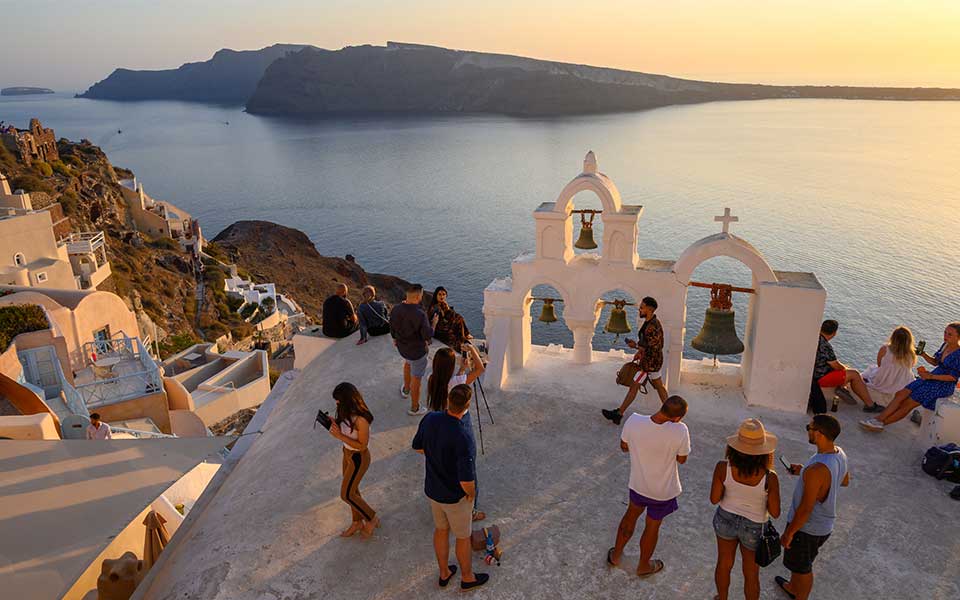Santorini is rapidly reaching the “red” zone of overtourism, an issue aggravated by the arrival of cruise ships and day-trippers from Crete and other islands. The island, once a serene paradise, is now an international example of an overcrowded destination that requires immediate action.
Santorini is far from solving its problems, with more than 500 large buses, 4,000 small passenger buses and vans, over 10,000 daily visitors, and hundreds of quad bikes joining the residents’ cars and rental vehicles as they navigate the inadequate road network and narrow streets of Oia, Fira, and other once peaceful villages.
In an interview with Kathimerini Newspaper, Santorini’s mayor, Nikos Zorzos, states that the island is paying the price for the unplanned and short-sighted development of low-value tourism, which degrades the travel experience and undermines serious tourism businesses that provide value-added services and genuinely contribute to the local economy. All of this occurs in an environment of excessive construction and short-term rentals, which deny young people, seasonal workers, and public employees of homes.

© Shutterstock
“The built-up area of the island has reached 20% of its total surface, higher even than that of Attica,” notes Nikos Zorzos. As a result, he emphatically urges “that not a single new hotel bed or short-term rental bed be constructed on the island.” And, because it is beyond his authority to implement this, he asks the government’s assistance in achieving it through legislation. “Construction outside zoning areas must also be completely stopped,” he adds. He also requires assistance in improving the island’s infrastructure, as building development there has been “exponential and inefficient.” However, his resources are limited. It is perhaps telling that he can’t even impose a token levy on cruise ship passengers: The rule limits the highest permitted fee for cruise ship passengers to 35 cents per passenger (0.35 euro). This fee is collected by municipal port funds and is standardized throughout Greece. And the difficulties don’t end there:
“When we took over the municipality at the beginning of the year, we found that the berth allocation system we had introduced years ago, which established a maximum limit of 8,000 passengers per day—a number derived from a university study on the island’s carrying capacity—had been abandoned,” he says. “We had 63 extremely challenging days ahead of us this year, with significantly more than 8,000 travelers. After several hard conversations with the cruise companies, we were able to reduce them to 48 days. “But even that is too many,” he says, clearly concerned.

He guarantees that in 2025, Santorini will not only stick to the 8,000 daily visitor limit, but will also include visitors who arrive on day trips from other islands such as Crete. After all, their number may be easily determined from the return tickets. In Santorini, Crete, and other adjacent islands, it is common knowledge that travel agents sell day trip packages to Santorini via regular ferry services. The mayor wants to limit the arrival of such ferries; however, in order to do so, he requires the assistance of the Ministry of Shipping because the operate on regular routes. “The current minister is aware of the issue and is seeking a solution to this difficult problem, at least more so than his predecessors,” he states.
Mr. Zorzos pledges that, in addition to enforcing the daily visitor restriction, cruise ships with specific features, such as low carbon dioxide and other pollution emissions, smaller size, and longer stays on the island, will be prioritized in 2025.
“We cannot talk about economic benefits when passengers only stay on the island for one or two hours at most,” he stresses, referring to the proven extremely low per capita spending in Santorini compared to other Mediterranean destinations. Additionally, he claims that arrivals will be scheduled based on stricter estimates of cruise ship occupancy, on the assumption that at least 90% of passengers will disembark.
According to the mayor, there have been days—and unfortunately, there may still be more to come—when cruise ships simultaneously unload up to 19,000 passengers on an island that cannot accommodate them. He promises to put an end to that in 2025. Fewer daily visitors would also reduce the demand for shuttle buses, which generate traffic congestion and even more serious issues when they need to park at their destinations. “In some circumstances, we discovered that asphalting specific locations helped mitigate the problem of double parking or uncontrolled stopping with hazard lights on. However, this is only a temporary solution; only careful planning, which will help limit the number of visitors and minimize overcrowding by dispersing them evenly throughout the island, will be able to heal the wounds caused by overtourism on Santorini.”
This article was previously published in Greek at www.kathimerini.gr












